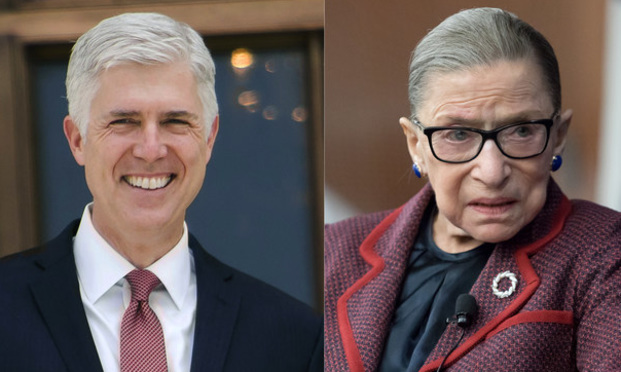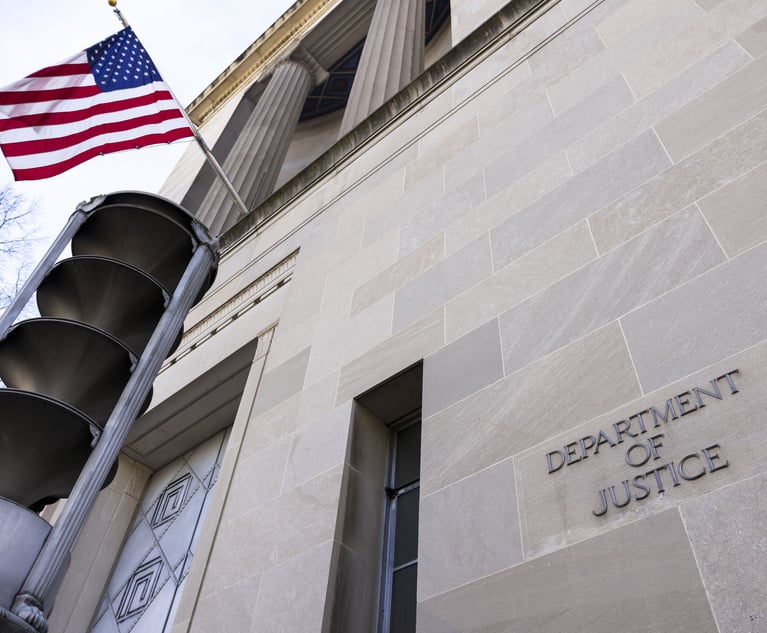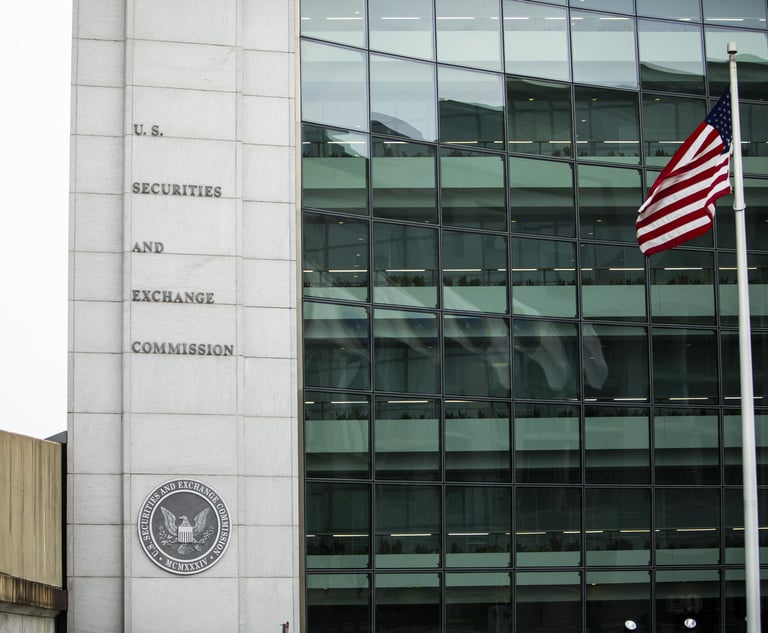Gorsuch Renounces Ginsburg's 'Apocalyptic' Warnings in Landmark Labor Case
Neil Gorsuch's 25-page majority opinion and Ruth Bader Ginsburg's 30-page dissent offered conflicting views. Ginsburg's dissent also reflected the growing skepticism of the fairness of arbitration among her liberal colleagues on a court that for many years has been strongly pro-arbitration across the board. The clash marked the second time in months the two justices took aim at each other in writing.
May 21, 2018 at 03:16 PM
6 minute read
 Justices Neil Gorsuch and Ruth Bader Ginsburg. Credit: ALM
Justices Neil Gorsuch and Ruth Bader Ginsburg. Credit: ALM
For the second time in recent months, Justices Ruth Bader Ginsburg and Neil Gorsuch engaged in dueling interpretations of federal law—but this time, the freshman justice prevailed over his senior colleague in his first major opinion.
The two justices went toe-to-toe in January in Artis v. District of Columbia, which involved interpretation of the tolling provision in the federal supplemental jurisdiction statute. Gorsuch in dissent presented a list of “absurdities” that would follow Ginsburg's interpretation for the court's majority. Ginsburg dismissed Gorsuch's “history lesson” on the common-law principle that he argued supported his interpretation.
Their roles reversed Monday in Epic Systems v. Lewis, consolidated with two other cases. The justices divided 5-4 along ideological lines to hold that workplace arbitration agreements banning class or collective actions do not violate the National Labor Relations Act, or NLRA. Those agreements, instead, are fully enforceable under the Federal Arbitration Act, according to the majority.
Gorsuch's 25-page majority opinion and Ginsburg's 30-page dissent offered conflicting views of the history and objectives of those two federal laws. Ginsburg's dissent also reflected the growing skepticism of the fairness of arbitration among her liberal colleagues on a court that for many years has been strongly pro-arbitration across the board.
Their disagreement in Epic Systems began with Gorsuch's opening statement of the issue before the justices. He wrote: “Should employees and employers be allowed to agree that any disputes between them will be resolved through one-on-one arbitration?”
To Ginsburg, there is no negotiation in these workplace arbitration agreements. Reading a summary of her dissent from the bench, she called them “arm-twisted, take-it-or-leave-it” contracts. They harken back, she wrote, to the high court's Lochner era when worker-protective legislation was struck down and illegal “yellow dog” contracts existed. The “Lochner era” refers to court's 1905 decision that struck down limits on working time.
“When a case challenging the NLRA's constitutionality made its way here, the court, in retreat from its Lochner-era contractual-'liberty' decisions, upheld the act as a permissible exercise of legislative authority,” Ginsburg wrote. “The court recognized that employees have a 'fundamental right' to join together to advance their common interests and that Congress, in lieu of 'ignor[ing]' that right, had elected to 'safeguard' it.”
Gorsuch, who spent a large chunk of his summary on the bench to answering Ginsburg, punched back at the Lochner reference twice, saying, first, “But like most apocalyptic warnings, this one proves a false alarm. Today's decision merely declines to read into the NLRA a novel right to class action procedures that the board's own general counsel disclaimed as recently as 2010.” And again, near the end of his majority opinion: “This court is not free to substitute its preferred economic policies for those chosen by the people's representatives. That, we had always understood, was Lochner's sin.”
And then there is Gorsuch's reference to an Obama-era general counsel of the National Labor Relations Board.
Gorsuch noted several times that the general counsel in 2010, Ronald Meisburg, wrote a memorandum reflecting the common understanding that the National Labor Relations Act said nothing about arbitration and could exist harmoniously with the Federal Arbitration Act.
“Remarking that employees and employers 'can benefit from the relative simplicity and informality of resolving claims before arbitrators,' the general counsel opined that the validity of such agreements 'does not involve consideration of the policies of the National Labor Relations Act,'” Gorsuch wrote. “To be sure, the employees do not wish us to defer to the general counsel's judgment in 2010 that the NLRA and the Arbitration Act coexist peaceably; they wish us to defer instead to the board's 2012 opinion suggesting the NLRA displaces the Arbitration Act.”
Ginsburg rejoined in a footnote: “The memorandum did not bind the board, and the board never adopted the memorandum's position as its own. Indeed, shortly after the general counsel issued the memorandum, the board rejected its analysis, finding that it conflicted with board precedent, rested on erroneous factual premises, 'defied logic,' and was internally incoherent.”
Gorsuch accused Ginsburg at one point of resting her interpretation on legislative history. “But legislative history is not the law,” he wrote. “Besides, when it comes to the legislative history here, it seems Congress 'did not discuss the right to file class or consolidated claims against employers.' So the dissent seeks instead to divine messages from congressional commentary directed to different questions altogether—a project that threatens to 'substitute [the court] for the Congress.'”
At one point in her dissent, Ginsburg said Gorsuch “paints an ahistorical picture” by contending that class and collective procedures were “hardly known” when the National Labor Relations Act was adopted in 1935.
Ginsburg pointed to language from Judge Diane Wood of the U.S. Court of Appeals for the Seventh Circuit, who once said the Fair Labor Standard Act's collective-litigation procedure and the modern class action were “not written on a clean slate.” “By 1935, permissive joinder was scarcely uncommon in courts of equity. Nor were representative and class suits novelties,” Ginsburg wrote. “Indeed, their origins trace back to medieval times.”
Although the two justices may have little in common ideologically, their approaches to deciding the issue were similar: direct, thorough in engaging each side's arguments, and easily followed. With 32 cases still awaiting decision, chances are good that they will have more opportunities to engage.
Read more:
Justices, Divided, Say Employment Contracts Banning Class Actions Are Lawful
Justice Ginsburg Scorns 'History Lesson' in This Gorsuch Dissent
Thomas and Gorsuch Call for Curbs on Federal Agency Power
Latest Rap on Gorsuch: He's a Rotten Writer
Supreme Court's Employment Contract Case Will Have Broad Reach. Here's How We Know
Susan Fowler, Uber's Thorn, Shares Her Story With the Supreme Court
This content has been archived. It is available through our partners, LexisNexis® and Bloomberg Law.
To view this content, please continue to their sites.
Not a Lexis Subscriber?
Subscribe Now
Not a Bloomberg Law Subscriber?
Subscribe Now
NOT FOR REPRINT
© 2025 ALM Global, LLC, All Rights Reserved. Request academic re-use from www.copyright.com. All other uses, submit a request to [email protected]. For more information visit Asset & Logo Licensing.
You Might Like
View All
Bankruptcy Judge Clears Path for Recovery in High-Profile Crypto Failure
3 minute read
Government Attorneys Face Reassignment, Rescinded Job Offers in First Days of Trump Administration
4 minute read
DC Judge Chutkan Allows Jenner's $8M Unpaid Legal Fees Lawsuit to Proceed Against Sierra Leone
3 minute readTrending Stories
Who Got The Work
J. Brugh Lower of Gibbons has entered an appearance for industrial equipment supplier Devco Corporation in a pending trademark infringement lawsuit. The suit, accusing the defendant of selling knock-off Graco products, was filed Dec. 18 in New Jersey District Court by Rivkin Radler on behalf of Graco Inc. and Graco Minnesota. The case, assigned to U.S. District Judge Zahid N. Quraishi, is 3:24-cv-11294, Graco Inc. et al v. Devco Corporation.
Who Got The Work
Rebecca Maller-Stein and Kent A. Yalowitz of Arnold & Porter Kaye Scholer have entered their appearances for Hanaco Venture Capital and its executives, Lior Prosor and David Frankel, in a pending securities lawsuit. The action, filed on Dec. 24 in New York Southern District Court by Zell, Aron & Co. on behalf of Goldeneye Advisors, accuses the defendants of negligently and fraudulently managing the plaintiff's $1 million investment. The case, assigned to U.S. District Judge Vernon S. Broderick, is 1:24-cv-09918, Goldeneye Advisors, LLC v. Hanaco Venture Capital, Ltd. et al.
Who Got The Work
Attorneys from A&O Shearman has stepped in as defense counsel for Toronto-Dominion Bank and other defendants in a pending securities class action. The suit, filed Dec. 11 in New York Southern District Court by Bleichmar Fonti & Auld, accuses the defendants of concealing the bank's 'pervasive' deficiencies in regards to its compliance with the Bank Secrecy Act and the quality of its anti-money laundering controls. The case, assigned to U.S. District Judge Arun Subramanian, is 1:24-cv-09445, Gonzalez v. The Toronto-Dominion Bank et al.
Who Got The Work
Crown Castle International, a Pennsylvania company providing shared communications infrastructure, has turned to Luke D. Wolf of Gordon Rees Scully Mansukhani to fend off a pending breach-of-contract lawsuit. The court action, filed Nov. 25 in Michigan Eastern District Court by Hooper Hathaway PC on behalf of The Town Residences LLC, accuses Crown Castle of failing to transfer approximately $30,000 in utility payments from T-Mobile in breach of a roof-top lease and assignment agreement. The case, assigned to U.S. District Judge Susan K. Declercq, is 2:24-cv-13131, The Town Residences LLC v. T-Mobile US, Inc. et al.
Who Got The Work
Wilfred P. Coronato and Daniel M. Schwartz of McCarter & English have stepped in as defense counsel to Electrolux Home Products Inc. in a pending product liability lawsuit. The court action, filed Nov. 26 in New York Eastern District Court by Poulos Lopiccolo PC and Nagel Rice LLP on behalf of David Stern, alleges that the defendant's refrigerators’ drawers and shelving repeatedly break and fall apart within months after purchase. The case, assigned to U.S. District Judge Joan M. Azrack, is 2:24-cv-08204, Stern v. Electrolux Home Products, Inc.
Featured Firms
Law Offices of Gary Martin Hays & Associates, P.C.
(470) 294-1674
Law Offices of Mark E. Salomone
(857) 444-6468
Smith & Hassler
(713) 739-1250









